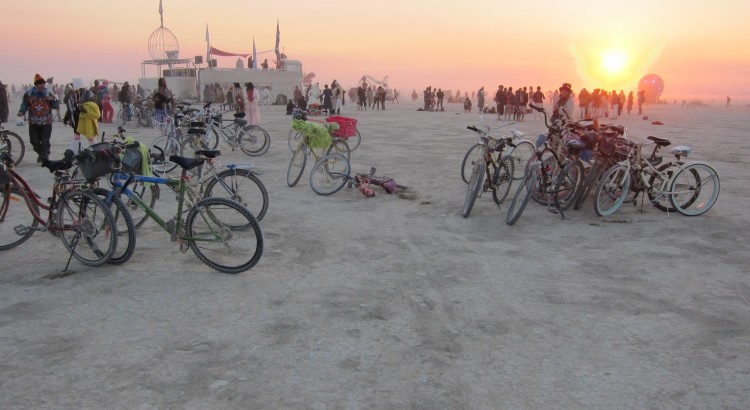The max exodus of San Francisco to the week-long annual event in the Nevada desert known as Burning Man is in progress. Before you leave you might want to learn how to utilize the power of the liminal space created at Burning Man.
This space is potent and if approached with intention, one can tap the wisdom and potential of the collective unconscious. See the end of this blog post for an exercise to take to Burning Man.
It’s a Rite of Passage
Like with any ritual process, going to Burning Man follows the three phases of a ritual. There is the separation from the “default world” as you journey to the desert. Once at the desert—or even once you start your preparation to leave—you enter an in-between space, a liminal space. Then, upon return, you reintegrate back into the default world.
Reintegration can be challenging and rough for many. Wherein a traditional rite of passage you would typically have the community and guides help you, we are left on our own to translate and integrate the experiences we had on the playa.
Burning man is a temporal liminal space ripe with potential for transformation. Our old identities have an opportunity to be questioned; new ones the opportunity to be played with. The playa is a stage for transformational change.
Burning man is a temporal liminal space ripe with potential for transformation. Our old identities have an opportunity to be questioned; new ones the opportunity to be played with. The playa is a stage for transformational change.
Collective Unconscious is the Stage
Burning Man is chock full of self-expression, manifested. Be it in the art cars, theme camps, massive art projects, costumes, the Temple, the Man, gift-giving, or experiences, there are so many opportunities to see what was initially internal (as an idea) be externalized and experienced. Where do all these ideas come from? C. G. Jung, the famous Swiss psychiatrist and psychotherapist who founded analytical psychology, would probably say they come from the collective unconscious.
C. G. Jung differentiated the collective unconscious from the personal unconscious which is a “more or less superficial layer of the unconscious” (Jung, 1959, p.3) that is filled with personal content like complexes. “This personal unconscious rests upon a deeper layer” (Jung, 1959, p.3)—the collective unconscious. The content of the collective unconscious is universal archetypes like what we find in myths, dreams, literature, and even marketing.
The content of the collective unconscious is universal archetypes like what we find in myths, dreams, literature, and even marketing.
How do you know if you’re interacting with elements from the collective unconscious? Anyone who as been to Burning Man most likely has a story where something happens of symbolic significance at an uncanny time. This is called synchronicity.
Synchronicity is the Guide
My partner and I were at Burning Man in 2014 and were sitting one night in a hammock in the middle of deep playa where we could see the parade of art cars going by. We were contemplating our intention which was to be open to what our life’s work would be this coming year. Immediately after saying that out loud an art car of a bridge drives in front of us. Bridging disciplines has been a theme in our work and seeing the bridge made that more clear. It also was the seed for this website.
Synchronicity is “the meaningful coincidence of two events, one inner and psychic (i.e. of the psyche) and the other outer and physical” (Stein, p. 234). For example, “an unconscious image comes into consciousness either directly (i.e. literally) or indirectly (symbolized or suggested)” (Sharp, p. 132). C. G. Jung believed that the psyche was not full of random experiences, but an emergence of a deeper order.
Synchronicity is “the meaningful coincidence of two events, one inner and psychic (i.e. of the psyche) and the other outer and physical.”
Individuation is the Path
Why do all this? C. G. Jung called the act of making conscious what was once unconscious, individuation. Individuation brings us towards wholeness, or more accurately, helps us remember the wholeness we already are.
Individuation brings us towards wholeness, or more accurately, helps us remember the wholeness we already are.
Happy travels! See you on the other side.
Exercise: How to have an Intentional Burning Man
Play with the collective unconscious and follow the synchronicity! Like with looking at dreams, you can look at your experience at Burning Man as a window into your psyche and the collective psyche.
Here are some basic steps:
- Set an intention
Do this before you leave (as many know, Burning Man starts before you arrive at the desert). Examples: find my passion, be more open, connect with my aliveness, letting go. - Review the intention
Do this throughout the week - Journal brief notes
Jot down a few lines to jog your memory later - Integration
Upon returning home, review your notes.- What themes did you notice?
- What insights/learnings did you have?
- What would you like to bring more into your life at home? How might you do that? What practices could help you (e.g. improv, volunteer, voice lessons, coaching, therapy, tango).
- If integration is challenging, find someone to process with. I offer these services and also know of many others as well.
Resources
Gilmore, Lee (2010). Theater in a crowded fire: Ritual and spirituality at Burning Man. Berkeley, CA: University of California Press
Jung, C. G. (1959). The archetypes and the collective unconscious (Translated by R. F. C. Hull). Bollingen Series, New York, NY: Princeton University Press
Sharp, Daryl (1991). C. G. Jung Lexicon: A primer of terms & concepts. Toronto, Canada: Inner City Books
Stein, M. (1998). Jung’s map of the soul: An introduction. Chicago: Open Court.
